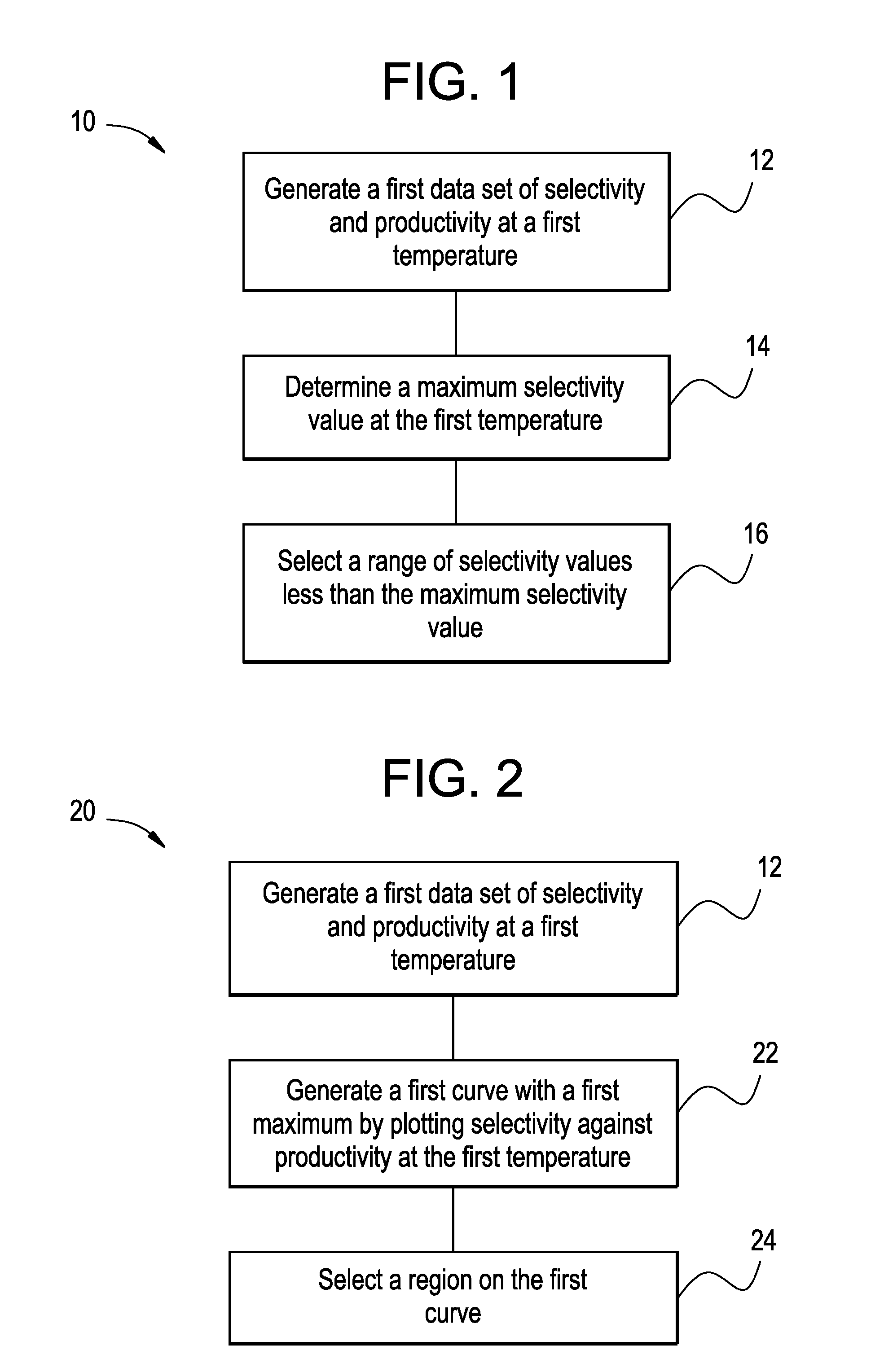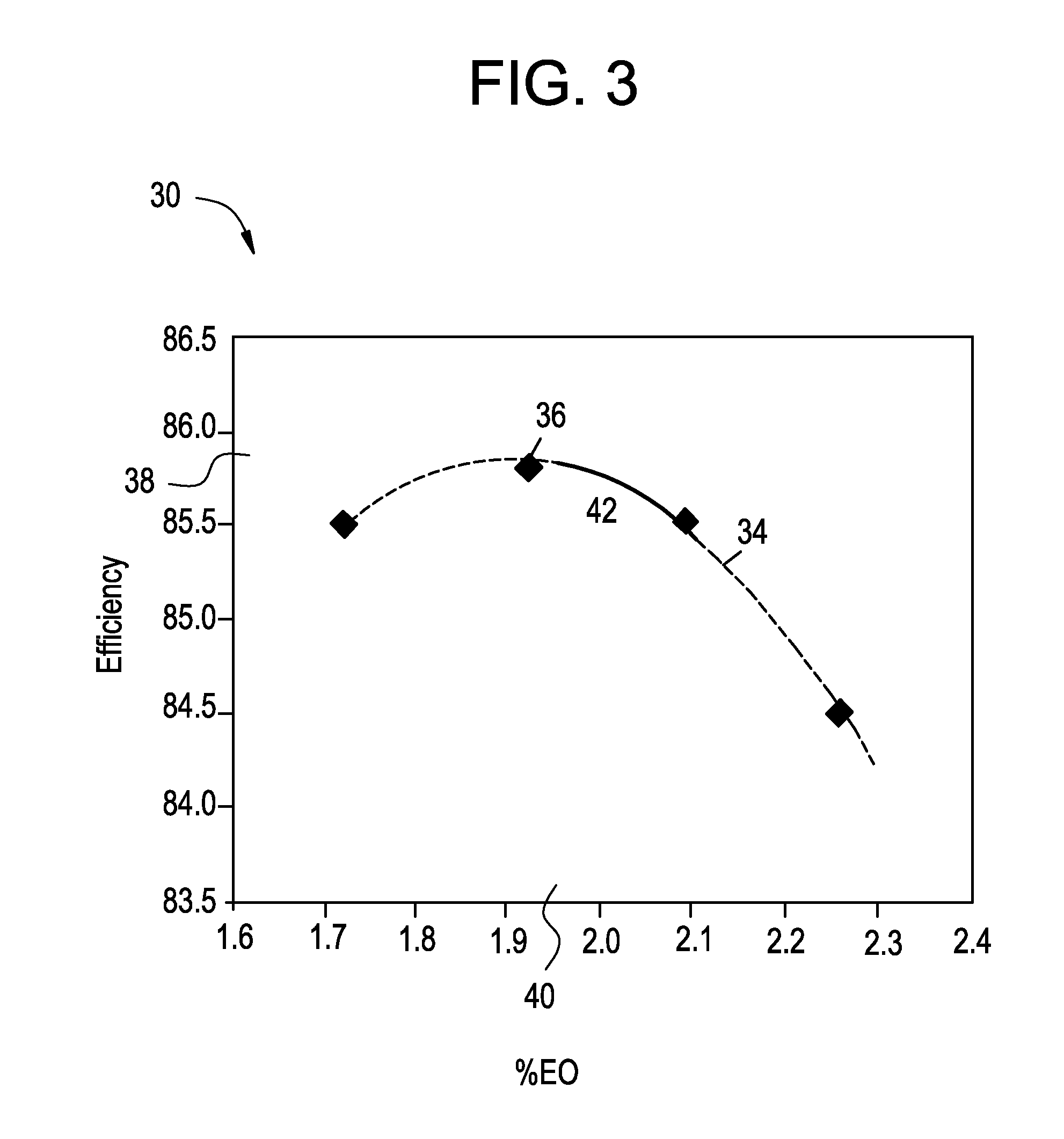Epoxidation reactions and operating conditions thereof
- Summary
- Abstract
- Description
- Claims
- Application Information
AI Technical Summary
Benefits of technology
Problems solved by technology
Method used
Image
Examples
example 1
[0111]This example illustrates the determination of the preferred operating condition using the plot method as described by the flow chart 50 and illustrated by the plot 60.
[0112]An alpha-alumina support is prepared using the general procedure as described in Patent Publication WO 2007 / 123932 and US Publication No. 2007-0111886 A1, incorporated herein by reference. A silver catalyst containing rhenium is prepared on the above alpha-alumina support using the general procedure as described in Patent Publication WO 2007 / 123932. X-Ray Fluorescence (XRF) analysis of the silver catalyst shows that it contains about 34.8 weight percent silver, about 572 ppmw cesium, about 60 ppmw total sodium, about 405 ppmw rhenium, about 115 ppmw sulphate and about 115 ppmw manganese. Lithium is also added as a promoter during the preparation of the catalyst, however it has not been analyzed using XRF. An 80-cc sample of the silver catalyst is run in a back-mixed autoclave reactor with an inlet gas compo...
example 2
[0115]This example illustrates performing the epoxidation reaction at the preferred operating condition for a cumulative alkylene oxide production of at least about 250 kmole per m3 of the catalyst.
[0116]A silver catalyst containing rhenium is prepared on the alpha-alumina support using the procedure as described in Example 1. The rhenium content of the catalyst is about 368 ppmw as analyzed by X-Ray Fluorescence. A sample of this catalyst is charged to a tubular reactor. The tubular reactor is configured such that a portion of a reactor outlet stream containing carbon dioxide is recycled after passing through an ethylene oxide absorber, and combined with sufficient fresh feed gases to achieve target inlet feed and re-introduced in to the reactor. The reactor is started up and the epoxidation reaction is operated under a range of process conditions for the first 50 days.
[0117]The reactor is operated between Day 51 and Day 61 by maintaining an inlet gas composition of 35 mole percent...
example 3
[0120]An 80 cc sample of the used catalyst of Example 2 is obtained from an outlet section of the catalyst bed. The epoxidation reaction is started up with the used catalyst in a back-mixed Berty-type autoclave reactor with an inlet gas composition of 30.0 mol percent ethylene, 8.0 mol percent oxygen, 2.0 mol percent carbon dioxide, 0.5 mol percent ethane, 2.0 ppmv ethyl chloride and the balance being nitrogen. The reactor pressure is 2000 kPa absolute (275 psig) and temperature is 230° C. The total reactor inlet feed gas flow is 640 standard liters per hour measured as nitrogen. After four days of operation at 230° C., the temperature is increased to 240° C.
[0121]A first data set on efficiency and productivity at a temperature of 240° C. is obtained by varying the inlet ethyl chloride concentration in steps of 0.3 ppmv to obtain Z* value in the range of about 3.1 to 4.3, and is provided in Table 3. A first plot 170 of efficiency against productivity is plotted and is given in FIG. ...
PUM
| Property | Measurement | Unit |
|---|---|---|
| Fraction | aaaaa | aaaaa |
| Fraction | aaaaa | aaaaa |
| Fraction | aaaaa | aaaaa |
Abstract
Description
Claims
Application Information
 Login to View More
Login to View More - R&D
- Intellectual Property
- Life Sciences
- Materials
- Tech Scout
- Unparalleled Data Quality
- Higher Quality Content
- 60% Fewer Hallucinations
Browse by: Latest US Patents, China's latest patents, Technical Efficacy Thesaurus, Application Domain, Technology Topic, Popular Technical Reports.
© 2025 PatSnap. All rights reserved.Legal|Privacy policy|Modern Slavery Act Transparency Statement|Sitemap|About US| Contact US: help@patsnap.com



